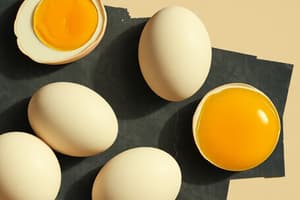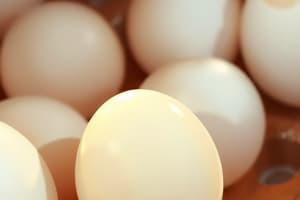Podcast
Questions and Answers
The egg is always perfectly spherical.
The egg is always perfectly spherical.
False (B)
What is a zygote?
What is a zygote?
A cell possessing all the nuclear and cytoplasmic components of other cells, in addition to certain particular characteristics.
What is the meaning of totipotency, with respect to eggs?
What is the meaning of totipotency, with respect to eggs?
The egg is a totipotent cell that can give rise to any cellular type of an organism, even to an entire organism.
What is found at the vegetal pole?
What is found at the vegetal pole?
What is axial symmetry?
What is axial symmetry?
What is bilateral or dorso-ventral symmetry?
What is bilateral or dorso-ventral symmetry?
What is an egg's food reserve mainly comprised of?
What is an egg's food reserve mainly comprised of?
Food reserves within an egg are said to be of what origin?
Food reserves within an egg are said to be of what origin?
RNA is more abundant in the vegetal pole (VP).
RNA is more abundant in the vegetal pole (VP).
What is the main function of an egg?
What is the main function of an egg?
What is the function of yolk?
What is the function of yolk?
What is vitellogenesis?
What is vitellogenesis?
Accumulation of reserves in an oocyte include which of the following?
Accumulation of reserves in an oocyte include which of the following?
What happens to the nucleus during previtellogenesis?
What happens to the nucleus during previtellogenesis?
What is another name for yolk deposition?
What is another name for yolk deposition?
At what stage does vitellogenesis start?
At what stage does vitellogenesis start?
What is the chemical nature of yolk?
What is the chemical nature of yolk?
What is yolk's origin?
What is yolk's origin?
What are the aggregates of proteins and lipids called in the cytoplasm of the egg?
What are the aggregates of proteins and lipids called in the cytoplasm of the egg?
What protein is mainly composed of yolk?
What protein is mainly composed of yolk?
What controls all vitellogenesis events?
What controls all vitellogenesis events?
What two components comprise vitellogenin?
What two components comprise vitellogenin?
What two characteristics determine the type of egg?
What two characteristics determine the type of egg?
What is the meaning of 'lecithal'?
What is the meaning of 'lecithal'?
What is another name for Alecithal?
What is another name for Alecithal?
Give an example of a creature with an Alecithal egg
Give an example of a creature with an Alecithal egg
What does 'oligo' mean?
What does 'oligo' mean?
Give an example of a creature with a Heterolecithal egg
Give an example of a creature with a Heterolecithal egg
In Alecithal eggs, the yolk quantity is _____.
In Alecithal eggs, the yolk quantity is _____.
In Oligolecithal eggs, the yolk is _____ distributed.
In Oligolecithal eggs, the yolk is _____ distributed.
In Heterolecithal eggs, the yolk is concentrated at the _____ pole.
In Heterolecithal eggs, the yolk is concentrated at the _____ pole.
In Centrolecithal eggs, the yolk is in the _____ of the egg.
In Centrolecithal eggs, the yolk is in the _____ of the egg.
In Telolecithal eggs, the yolk is at the _____ pole.
In Telolecithal eggs, the yolk is at the _____ pole.
Flashcards
Egg Characteristics
Egg Characteristics
The egg is usually spherical and may be enclosed in membranes for protection and nutrients.
Zygote
Zygote
A zygote is a cell possessing all the nuclear and cytoplasmic components of other cells.
Totipotency
Totipotency
The ability of a cell to give rise to any cell type of an organism, even an entire organism.
Vegetal Pole
Vegetal Pole
Signup and view all the flashcards
Animal Pole
Animal Pole
Signup and view all the flashcards
Axial Symmetry in Eggs
Axial Symmetry in Eggs
Signup and view all the flashcards
Bilateral Symmetry
Bilateral Symmetry
Signup and view all the flashcards
Food reserves in eggs
Food reserves in eggs
Signup and view all the flashcards
Gradients in components of eggs
Gradients in components of eggs
Signup and view all the flashcards
Vitellogenesis
Vitellogenesis
Signup and view all the flashcards
Previtellogenesis
Previtellogenesis
Signup and view all the flashcards
Vitellogenesis (yolk deposition)
Vitellogenesis (yolk deposition)
Signup and view all the flashcards
Vitellogenesis (timing and origin)
Vitellogenesis (timing and origin)
Signup and view all the flashcards
Vitellogenin
Vitellogenin
Signup and view all the flashcards
Vitellogenin's fate
Vitellogenin's fate
Signup and view all the flashcards
Types of Eggs
Types of Eggs
Signup and view all the flashcards
Alecithal/Microlecithal Eggs
Alecithal/Microlecithal Eggs
Signup and view all the flashcards
Oligolecithal Eggs
Oligolecithal Eggs
Signup and view all the flashcards
Heterolecithal Eggs
Heterolecithal Eggs
Signup and view all the flashcards
Telolecithal Eggs
Telolecithal Eggs
Signup and view all the flashcards
Centrolecithal Eggs
Centrolecithal Eggs
Signup and view all the flashcards
Study Notes
General Characteristics
- An egg is generally spherical and enclosed in protective or nutrient-containing membranes.
- A zygote (fertilized egg) has all nuclear and cytoplasmic components of other cells, plus some unique characteristics.
Totipotency
- An egg is a totipotent cell, meaning it can give rise to any cell type of an organism, even an entire organism.
- The zygote is the best example of a totipotent cell.
- This totipotency is lost during embryonic development.
Polarity
- Vegetal Pole: Rich in yolk
- Animal pole: Site of emission of polar bodies, poor in yolk, contains the nucleus and active cytoplasm.
Symmetry
- Before fertilization, the egg exhibits axial symmetry.
- After fertilization, most coelomate metazoa develop bilateral or dorso-ventral symmetry during embryonic development.
Food Reserves
- Eggs import or produce food reserves, mainly yolk, for the early oogenesis consumed during embryonic development.
- Food reserves can be of exogenous or endogenous origin and consist of protein, lipid, or carbohydrate.
Heterogeneous
- The distribution of egg components, such as ribosomes, mitochondria, and yolk, occurs in a gradient system.
- RNA Gradient: RNA is more abundant in the animal pole, increasing from the vegetal pole (VP) to the animal pole (AP).
- Yolk Gradient: Yolk is more abundant in the vegetal pole, increasing from the animal pole (AP) to the vegetal pole (VP).
Vitellogenesis
- The egg initiates and directs development.
- An egg can import, develop and store reserves in its cytoplasm.
- Yolk in the egg's cytoplasm serves as a nutritive reserve for the embryo at the beginning of development.
- Accumulation occurs mostly during meiotic prophase I, subdivided into previtellogenesis and vitellogenesis.
Previtellogenesis
- This is a phase of slow oocyte growth.
- A large amount of rRNA, mRNA, and tRNA, ribosomal and functional proteins are synthesized and stored.
- Nuclear sap is produced; the nucleus increases in size and becomes a germinal vesicle.
Vitellogenesis
- Also known as yolk deposition
- This involves the accumulation of nutritional reserves in the oocyte's cytoplasm, starting during the diplotene stage of prophase I of meiosis.
- Vitellus, yolk, or deutoplasm are lipoproteins composed of proteins, phospholipids, and a small amount of glycogen.
- Exogenous origin
- Yolk accumulates in the egg cytoplasm during growth and maturation as yolk platelets.
- The reserve material is from the maternal organism, accumulating during the growth and maturation phase of oogenesis and being used during embryonic development.
- Vitellogenesis occurs when oocytes reach the diplotene stage of prophase I of meiosis. Amphibian oocytes can remain blocked for years in prophase 1 diplotene.
- The yolk is mainly composed of vitellogenin, a protein synthesized in the liver and transported to the ovaries via blood circulation.
- All the events are controlled by hormonal interactions between the hypothalamus and the ovaries cells.
- In the mature oocyte, vitellogenin becomes phosvitin and lipovitellin forming vitelline (yolk) platelets.
Types of Eggs based on Yolk
- The type of egg is determined by the amount of yolk and its distribution in the cytoplasm.
- Egg size and cleavage depend on yolk content.
- Lecithal: Having yolk
Alecithal/Microlecithal
- Small sized egg, very poor in yolk.
- Found in placental mammals.
Oligolecithal (oligo=few)
- Possess a small amount of yolk uniformly distributed throughout the cytoplasm.
- Examples include some echinoderms (starfish, sea urchin) and amphioxus.
Heterolecithal (hetero=different)
- Contain a moderate amount of yolk heterogeneously distributed in the cytoplasm.
- More yolk is found in the vegetal pole than the animal pole.
- Active cytoplasm is concentrated at the animal pole.
- Found in amphibians (frogs).
Telolecithal (telo=at the end)
- Large egg, rich in yolk at the vegetal pole.
- Active cytoplasm and nucleus occupy a small region in the animal pole (blastodisc).
- Found in reptiles, birds, and some fish (trout).
Centrolecithal (centro=in the middle)
- Moderate size.
- Yolk is concentrated in the center of the egg.
- Cytoplasm is present as a thin peripheric layer on the surface, near the membrane.
- The nucleus is surrounded by little cytoplasm (ooplasm) inserted between yolk blocks.
- Example: Insects.
Studying That Suits You
Use AI to generate personalized quizzes and flashcards to suit your learning preferences.





